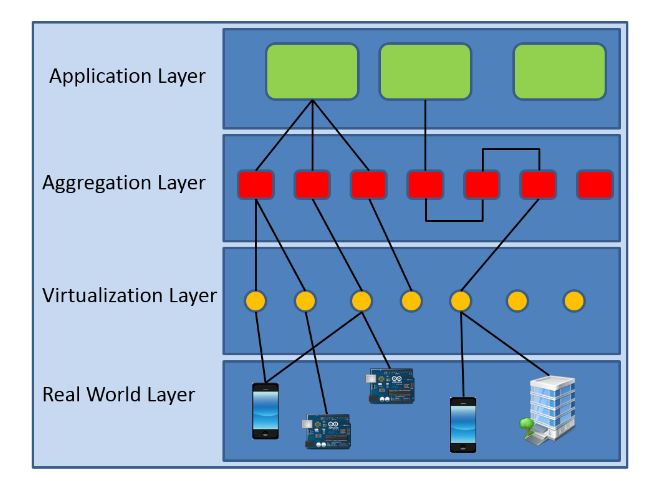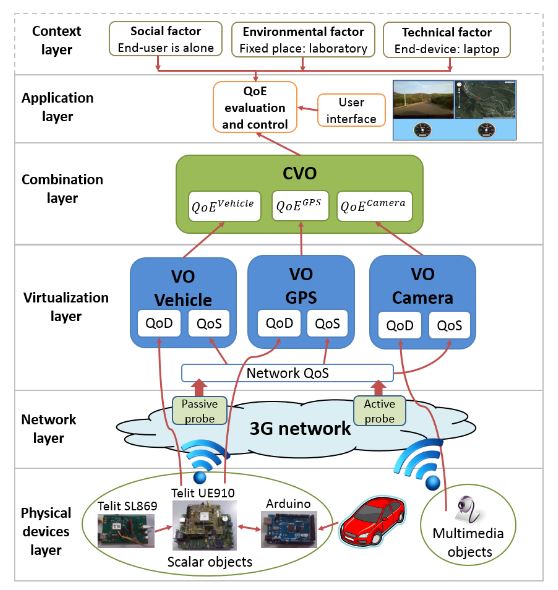ABSTRACT
This paper addresses the issue of evaluating the Quality of Experience (QoE) for Internet of Things (IoT) applications, with particular attention to the case where multimedia content is involved. A layered IoT architecture is firstly analyzed to understand which QoE influence factors have to be considered in relevant application scenarios. We then introduce the concept of Multimedia IoT (MIoT) and define a layered QoE model aimed at evaluating and combining the contributions of each influence factor to estimate the overall QoE in MIoT applications.
Finally, we present a use case related to the remote monitoring of vehicles during driving practices, which is used to validate the proposed layered model, and we discuss a second use case for smart surveillance, to emphasize the generality of the proposed framework. The effectiveness in evaluating classes of influence factors separately is demonstrated.
BACKGROUND

Figure 1. The considered four-layer model for IoT architectures
Even if there is not a reference IoT architecture, we may say that a general four-layer model is generally followed as illustrated in Figure 1. A major feature of this model is the use of the virtual object, which is a digital representation of the physical object. One specific implementation that follows this architecture is the iCore solution, which exploits and leverages the adaptation capabilities offered by the platform in terms of virtualization, aggregation and abstraction properties.
PRELIMINARY ANALYSIS

Figure 3. Multimedia IoT (MIoT) scenarios
The first scenario is represented by the use case depicted in Figure 3a, where some surveillance cameras record images and audio of a place. This multimedia information is collected by an IoT application and presented in a multimedia way (images, videos, audios) in order to provide a remote security control service. Figure 3b illustrates the second scenario. A camera records some images of people who want to enter in a place where the entrance is allowed only to authorized persons.
LAYERED QOE MANAGEMENT FRAMEWORK FOR MIOT APPLICATIONS

Figure 5. Framework of the MIoT vehicle application for remote tutoring for driving school lessons
Figure 5 shows the proposed QoE framework applied to this specific vehicle application. The physical device layer accounts for the physical devices acquiring the information needed by the application; these are an Arduino Mega 2560, the Telit UE910-EUR and SL869 modules, and a camera. The Arduino Mega 2560 is connected to the On-Board Diagnostic interface (OBD-II) of the vehicle and is able to acquire vehicle parameters. For this use case, we acquired the speed and revolutions per minute (rpm) parameters. The Telit SL869 module is provided with a Global Positioning System (GPS), which acquires the position coordinates of the vehicle with the current date and time.

Figure 9. MOS results with 95% CI comparing analog and digital presentation of vehicle parameters being equal in the other conditions
This means that, in this specific application, the end-users are more interested in the accuracy and synchronization of the vehicle data than in the quality of the video sequences. With regard to the presentation of the vehicle data, MOS for digital data presentation have, in the majority of cases, slightly higher values than MOS for analog data presentation, as shown in Figure 9. In fact, except for TCs concerning delayed data (TC3, TC4, TC9, TC10), the users preferred digital data visualization. This could be due to the fact that digital indicators are more precise than analog indicators since the user can know the exact values of the vehicle speed and rpm.
FUTURE CHALLENGES AND CONCLUSIONS
The Internet of Things encompasses an enormous plethora of applications that will be deployed thanks to the combination of information and services provided by heterogeneous objects, exploiting also opportunistic objects cooperation. These can also be deployed on the fly according to the temporary needs of the users. In this scenario, the evaluation of the QoE becomes even more challenging than what characterizes fixed and well-defined applications scenarios, such as those related to voice and video conferencing. With the proposed layered QoE model, we intend to simplify the evaluation and combination of the contributions of each influence factor to estimate the overall QoE in IoT, with particular attention to multimedia IoT applications.
Whereas the proposed methodology gives some directions in this respect, there are key factors that can be obstacles to its use, and there are still challenges to be addressed in any case to make it effective. One of the major obstacles is the adoption of a reference IoT architecture, which is far from being accepted by the relevant community. Whereas we believe that the composition of simple services will still continue to exist (and then, the relevant combination layer in our model), as it is a key characteristics of also the Internet of Service we have used since at least a decade ago, the role of the key role of the virtual object is still to be proven.
In particular, the VO could be divided into different functionalities, some implemented in the physical object and some in the cloud, so that the relevant layer in our model should be split accordingly. As to the challenges, even if trivial, it is worth mentioning that several models are still missing to make the proposal effective. Just to mention one, the QoD for the video signal is still to be defined, and only a few of the existing models can be applied to our case. Additionally, the presence of difference objects also owned by different persons and organization requires that the quality provided by each object and communicated to the VO is reliable, and for this, appropriate actions should be taken to assess the trustworthiness of the objects in this respect.
Source: University of Cagliari
Authors: Alessandro Floris | Luigi Atzori